
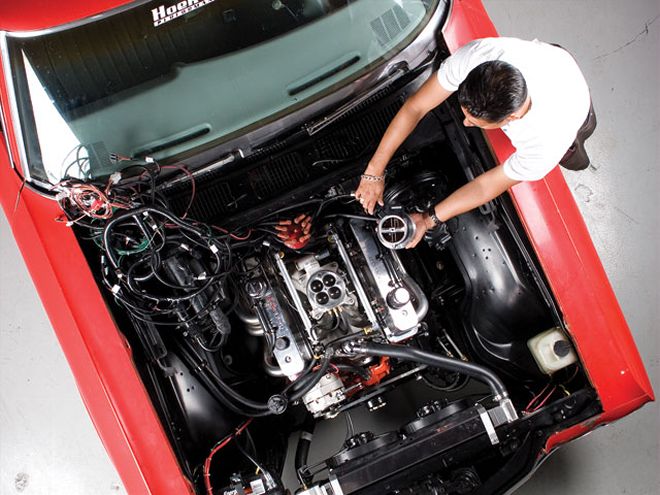
For most of us, the chief requirement for aftermarket direct-port electronic fuel injection is the elimination of the after-installation hassle factor. We anticipate a nest of wiring, fuel system routing, and fabrication-that's understood and worn as a badge of honor in hot rodding. While routine laptop tuning may wow your friends, we'd rather cruise with Della in the shotgun seat-not the Dell.
What we really want is the convenience of a carburetor with the precision that computer-controlled EFI offers. Crisp throttle response and thrifty fuel usage is why we would even consider going through the effort. However, if an EFI system provides improved horsepower, torque, and fuel economy, the company providing such would rule the world.
Enter Chris Richards from Mass-Flo EFI. We first met Richards in the Feb. '05 issue of HOT ROD when Steve Magnante introduced us to his adaptation of Ford's electronic engine controller (EEC) fuel-injection system employed on 5.0L Mustangs. Richards ingeniously packaged the electronic engineering from Ford with a high-flow single-plane manifold, an improved GM MAF sensor, a wiring loom with all the necessary connectors, and a 1,000-cfm throttle body and at the same time, talked personally with every customer.
Richards has expanded his lineup to include 24 different applications powered by Ford mass air management via an EEC computer. Got an AMC that needs fuel injection? Richards has you covered. Caddy, no problem. Oldsmobile, Studebaker, or in our case, a 406ci Chevy small-block, then you are looking in the right place. In fact, if there is a single-plane intake manifold available for your engine, Mass-Flo can make a custom system for it.
Additionally, this sequentially-fired, direct-port injection delivers performance. We sought to find out if it was better than the old standard, a four-barrel Holley right out of the box. That was our agenda: bolt a Holley 4150 Street HP 750-cfm carb (PN 0-82750) without rejetting and make only idle speed and idle mixture adjustments. The same would be true of the Mass-Flo system. We'd install it right out of the box on the same 4,200-pound '70 Malibu Concours wagon. Motivated by a Comp Cams Xtreme Energy-cammed 406ci stroker fitted with a single-plane Victor Jr. and a set of RHS Vortec-style high-swirl iron heads, the combination makes for a ragged line of true streetability that we hope to tame with the Mass-Flo system.
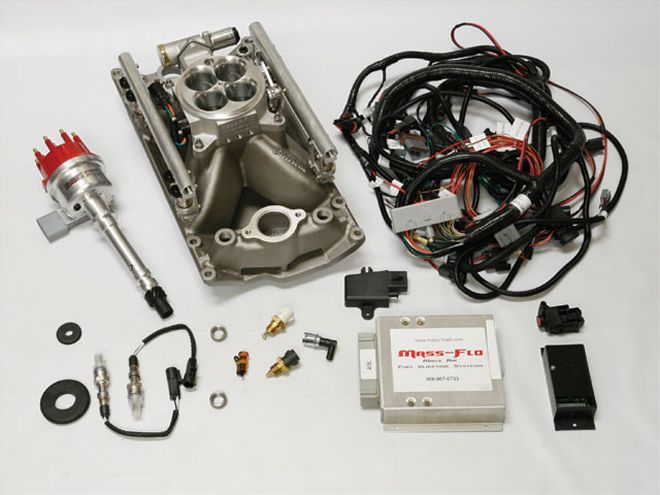
The Mass-Flo system contains all necessary sensors, including the air charge temperature sensor, barometric pressure sensor, coolant temperature sensor, idle air control valve, throttle position sensor, modified GM MAF sensor (not included in image here), and a pair of oxygen sensors. Also supplied is a Thick Film small-cap Mallory distributor, the complete EFI harness specific to the engine application, an intake manifold (available for small-block Chevy and Ford applications, but Mass-Flo can modify any aftermarket single-plane V-8 manifold), and the Mass-Flo-calibrated Ford-engineered electronic engine controller. You can choose to either acquire all of the plumbing and accoutrements from Mass-Flo or do as we did and use items you already have in your inventory to complete the installation. In many cases, your current carbureted setup may offer the needed parts, except for the EFI-specific fuel pump, filter, and pressure regulator. The price is $2,995.00.
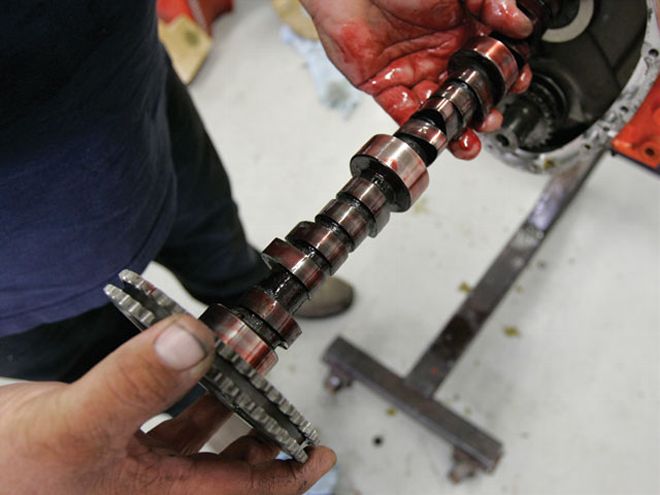
Our test was built around this 406ci small-block. We fitted it with RHS Pro Torker Chevy Vortec cast-iron cylinder heads (PN 12410) and a Comp Cams Xtreme Energy XE268H grind (PN 12-242-2; advertised duration 268/280; duration at 0.050-inch lift 224/230). To keep the comparison between carburetor and fuel injection as even as possible, we chose to top off the carb combination with the same Vortec-style Edelbrock Victor Jr. intake manifold (PN 2913) that the Mass-Flo EFI system includes but modified with direct port injection. Since when we first acquired the Mass-Flo system, Chris Richards has sourced his own single-plane manifold as part of the Mass-Flo small-block Chevy kit. A Mass-Flo single-plane intake is also available for Ford applications.
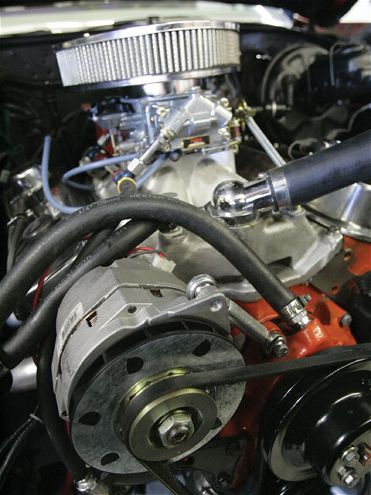
Battery voltage was a major concern with the EFI system. With that in mind, we upgraded the stock 40-amp alternator to this 100-amp unit for both the carbureted and fuel-injected tests. We'd need 15 amps alone for the fuel pump, not to mention individual injector and computer demand, and opted for the upgrade for both baseline and EFI tests.
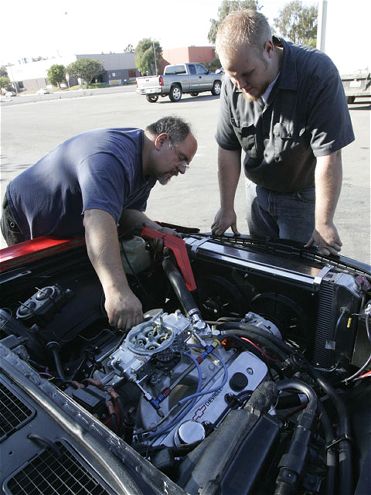
Our can-do administrator on the project, Ed Taylor, sets the timing at 14 degrees initial with 34 degrees total advance as Aaron Hoekstra looks on. Taylor also set the EFI at the same base timing to achieve a total of 34 degrees advance as the Mass-Flo massaged EEC computer dials in 20 degrees of advance.
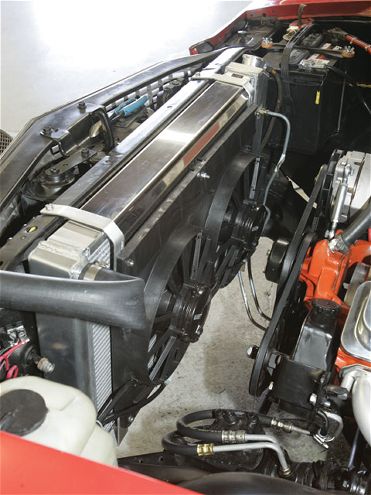
The baseline vehicle, a '70 Malibu Concours station wagon, was in dire need of a few items to aid us in reliability and consistency. One of the necessary upgrades was provided by Be Cool Radiators. Its Super Street Series radiator assembly (PN 82008) includes the dual electric fans, trick temperature sensor, and all mounting hardware and wiring for a no-hassle installation.
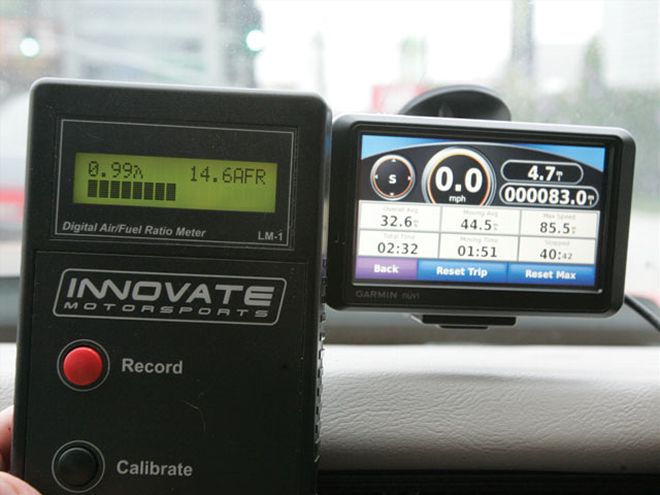
We left nothing to chance in monitoring air/fuel ratios and evaluating the results. We used an Innovate Technologies O2 sensor and the LM-1 monitor to check on the tune of the carb and fuel injection, along with air/fuel graphing at Bottle Blown Racing on its SuperFlow chassis dyno. We liked what we saw on the occasional glance at the air/fuel ratios with the carburetor, witnessing power-producing 12.0:1 ratios under hard throttle. But on deceleration, the carb went dead rich, while the Mass-Flo went to 15:1 on deceleration. Rather than depend on the odometer, we used a Garmin Nuvi GPS to precisely measure distance for our 143-mile fuel-efficiency runs as the odometer/speedometer was approximately 35 percent off.
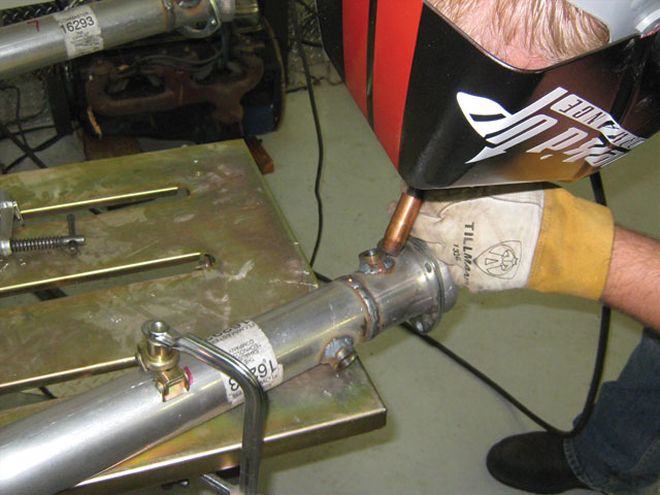
Hoekstra also installed the O2 bungs in the full-length exhaust (PNs 5021 and 1032). The system was installed by Hoek'd Up Performance to exit behind the rear tires and features Hedman 1 3/4-inch headers and Flowmaster Super 40 mufflers.
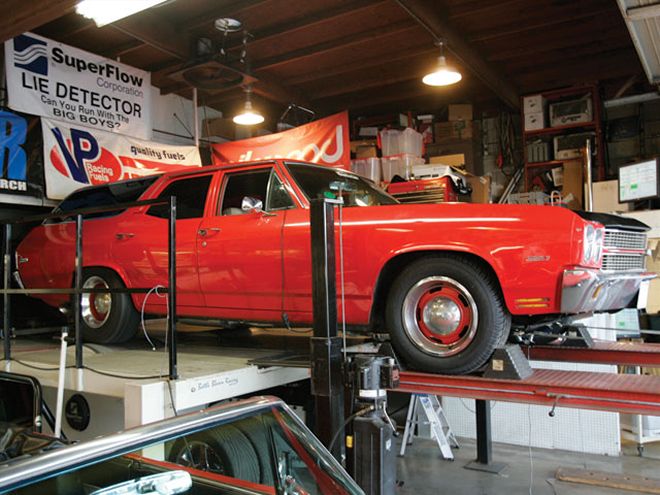
Tommy Velasquez and Brooke Torbron of Bottle Blown Racing in Camarillo, California, provided third-party verification of the performance of our 4,200-pound station wagon. Bottle Blown Racing uses a SuperFlow chassis dyno, and while the overall length of the wagon challenged the dimensions of the dyno, we were sure to get a pair of consistent back-to-back readings to establish our baseline and performance tests.
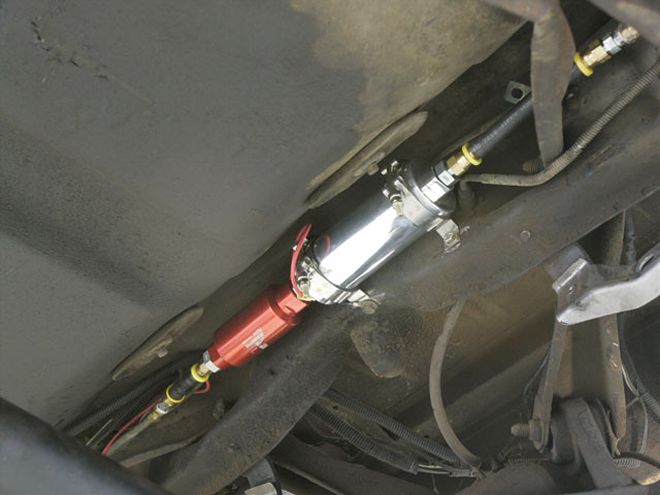
Despite the unconventional location of the fuel tank in the station wagon (in the quarter-panel), the upright tank location proved to be a blessing, as conventional tanks require a fuel trap to prevent fuel sloshing and starvation under hard acceleration. Rather than run new lines, Taylor determined that the stock 3/8-inch line would be sufficient for fuel delivery and suggested we use the 5/16-inch vapor recovery line as the return line and use the 1/4-inch fuel pump vent line as the vent. That worked perfectly and allowed us to plumb the system without having to route new lines. We opted to use an Aeromotive Platinum-series in-line pump (PN 11156) with an Aeromotive fuel filter (PN 12301) mounted aft. For more on the topic of fuel line retrofits for fuel injection and the mandatory change to high-pressure fittings, see the sidebar "Under Pressure."
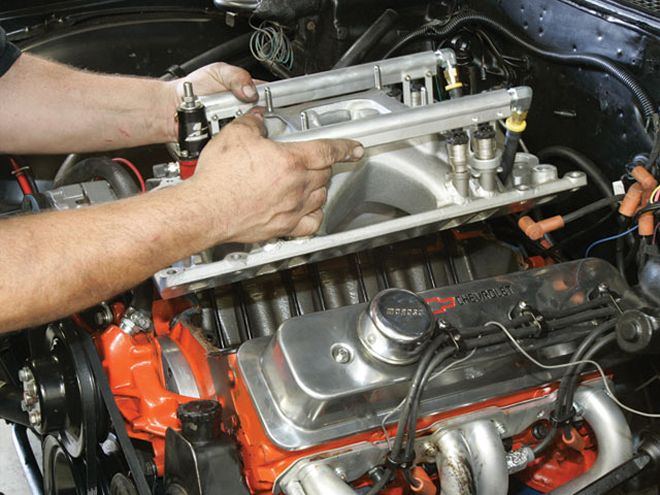
With the fuel plumbing behind us, Taylor removed the carburetor and intake and dropped the Mass-Flo EFI intake in place. The advantage of direct port injection is it nearly eliminates the fuel distribution problems associated with first-gen Chevy small-blocks, especially due to the siamesed port design. Today's LS-series engines offer symmetrical ports and thus superior fuel distribution.
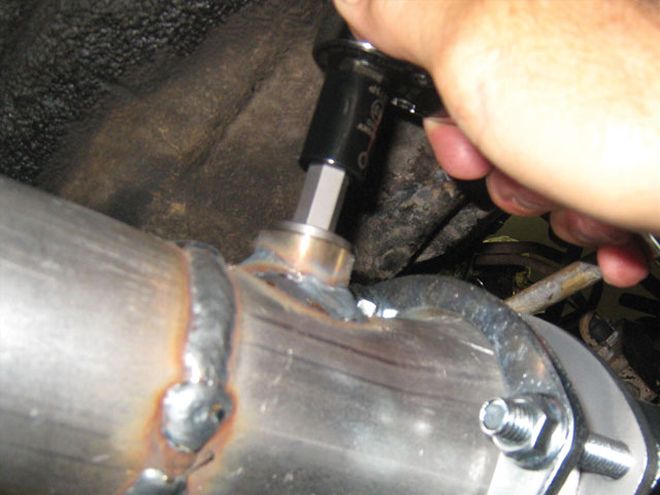
Mass-Flo's pair of O2 sensors was installed aft of the collector flange in the Flowmaster exhaust. The EEC computer tells the system a target air/fuel ratio and the O2 sensor relays information back to the computer to richen or trim fuel delivery to meet the programmed target. The more you drive the mass airflow system, the more trim and enrichment cycles are acquired and adapted.
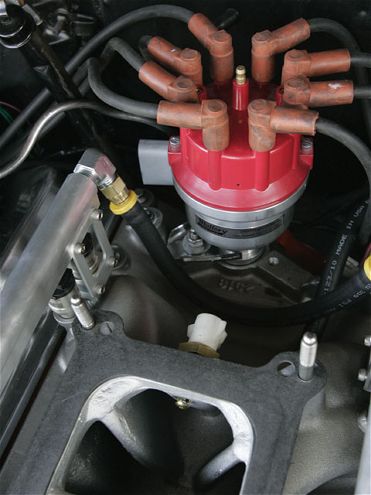
The air-changed temperature sensor is manifold-mounted in the Mass-Flo kit. Timing is controlled by the Mallory TFI distributor. Thick Film ignition distributors began appearing in Ford vehicles in 1990, most notably the 5.0L Mustang.
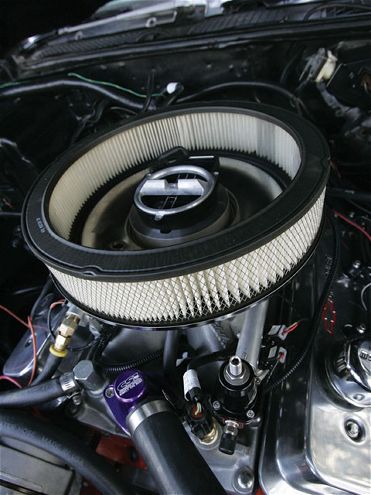
We already installed a '70 to '72 Chevelle SS-style hood (PN KR02116) from Original Parts Group to replace the flat hood. and accommodate the taller Victor Jr. single-plane manifold for both test sessions. The EFI air cleaner assembly was set up using a 14-inch-diameter, 0.750-inch-raised air filter base (SUM-G3000B). That provides clearance for the idle air speed motor mounted to the 1,000-cfm Mass-Flo throttle body. We cut a 1 1/4-inch hole in the base to route the supplied MAF sensor jumper harness. A 3-inch element is shown. A 195-degree thermostat is under the swivel thermostat housing. The EEC system needs to see higher temps to move the computer off of the fuel-enrichment cycle. Think of that cycle as the electronic version of a carb choke.
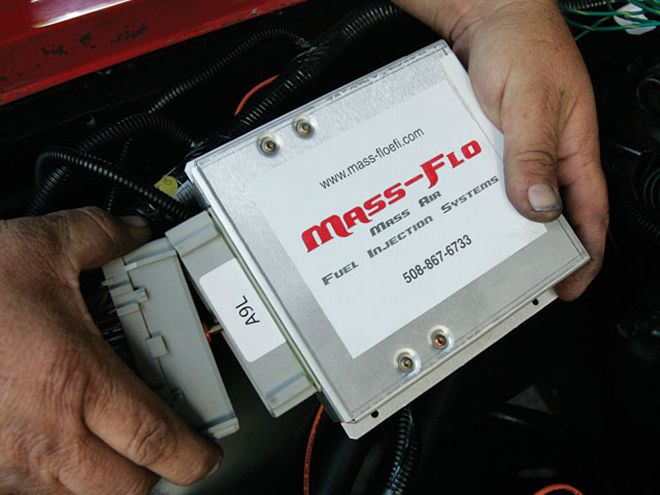
We've all become accustomed to 9-inch Ford rearends in our Chevrolets. How about a Ford electronic engine controller? Richards borrows from the proven capabilities of millions of 5.0L Mustangs to establish the tuning parameters for this mass airflow system while using a modified GM MAF unit mounted atop the air cleaner base. Best of all, no laptop calibration is necessary, as Mass-Flo programs each customer's EEC computer to match the injectors and expectations to his specific application. The mass airflow system measures actual airflow, as opposed to the speed-density method of calculating the fuel map from other sensor data. As the computer learns the fuel and air demands of the engine, the electronic engine controller adapts to the air, fuel, and spark needs of the engine. However, disconnect the battery and all that adaptive learning is lost.
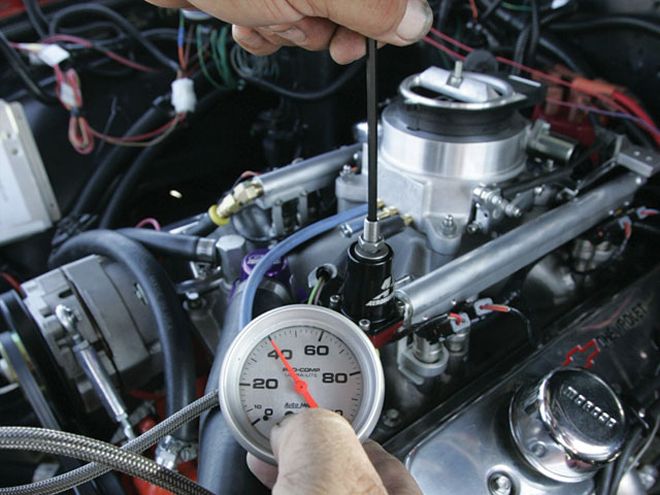
Once the engine was up and running, we followed the instructions and set the fuel pressure at the Aeromotive regulator (PN 13105) at 40 psi with the vacuum line disconnected. Complete instructions are provided by Mass-Flo, and Richards is available to answer questions related to the installation and places that phone number throughout his detailed instructions.
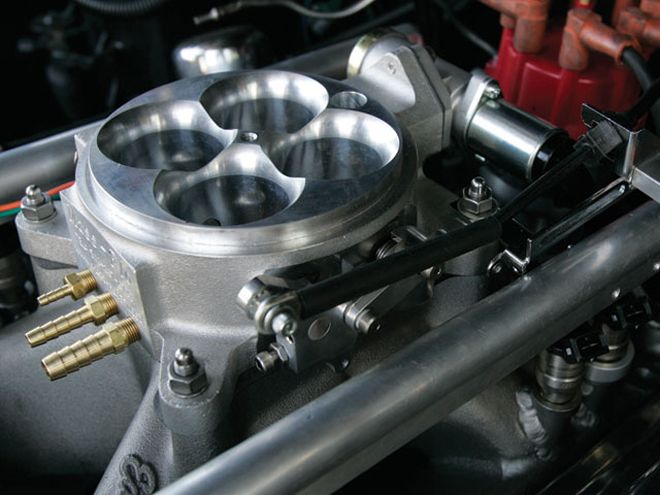
With inventory on hand, Taylor was able to modify a summit adjustable throttle cable bracket (PN SUM-G1414). Note that we opted to not hook up the kickdown linkage for our testing.
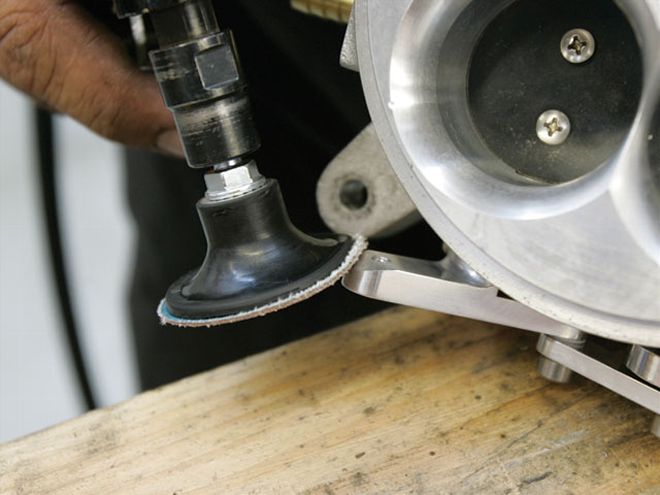
Be ready for a little garage engineering on detail parts such as the linkage. Here Taylor modifies the throttle lever to gain acceptable clearance with the air cleaner flange, which interfered with this lever.
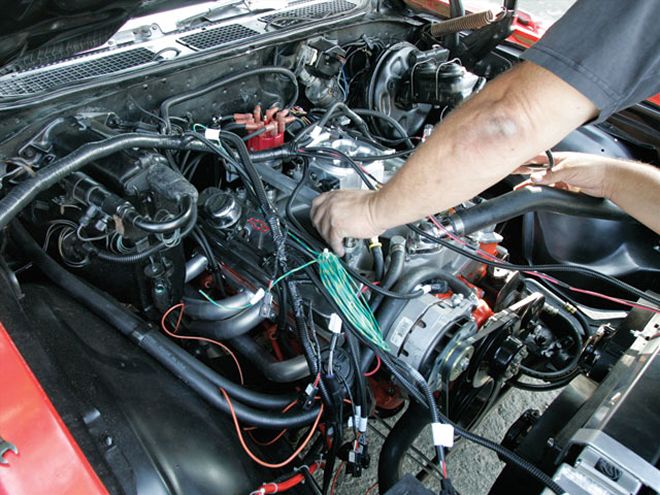
While the harness installation appears menacing, Richards has matched the connectors to the various sensors and labeled them precisely to aid in the installation.
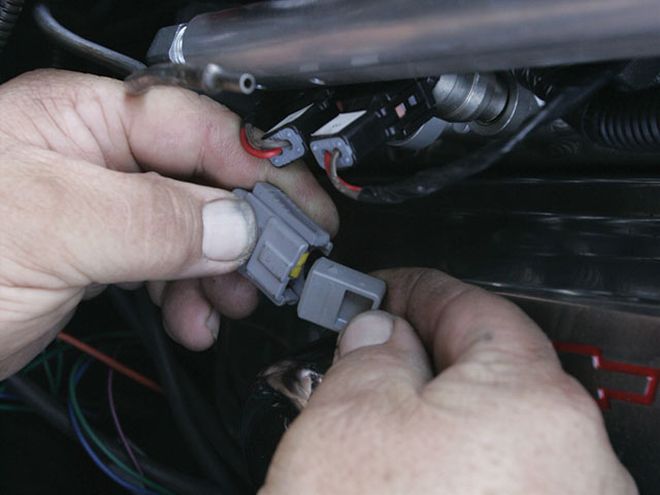
To establish base timing, recognize that the computer can add up to 20 degrees of total advance. To match the settings we used on the carbureted setup, Taylor unplugged the SPOUT (SPark OUTput) connector and set the initial advance at 14 degrees. When plugged in, total advance reached 34 degrees.
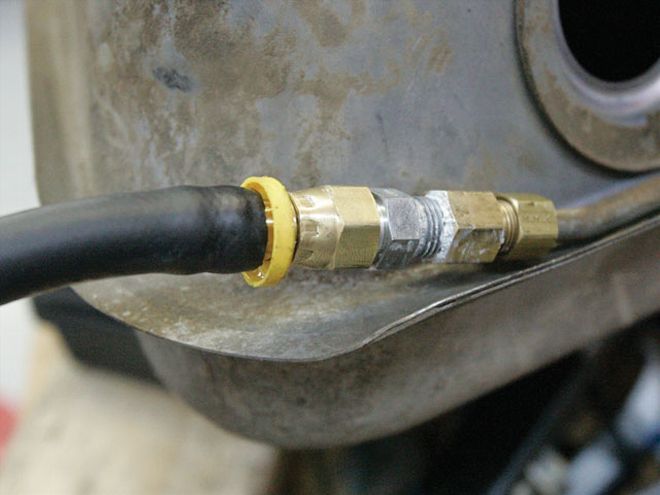
Bottle Blown Racing's Tommy Velasquez noted as he put the car on the dyno that he anticipated more power from the EFI system based on the crisp throttle response and low-speed torque. One puzzling result was the relatively rich conditions noted on the dyno. We assume adaptive learning for the EEC computer had not been established despite 150 miles of driving before the final test, and trimming the fuel curve will likely continue with WOT testing. What isn't illustrated here is the seat-of-the-pants driving impression. With the carburetor, we originally thought we had converter issues, as the heavy wagon simply lacked low-speed torque. Upon installation of the Mass-Flo system, the throttle response was vastly improved, easily breaking the rear wheels loose. The car started immediately with a twist of the key, and at cruising speeds, the fuel injection was far smoother and the secondary throttle blade transition was seamless.
Numbers at a Glance Peak Rear-Wheel HPPeak Rear-Wheel TorqueMileage Loop 143 hwy miles*Carb Baseline279.9 at 4,{{{600}}}331.3 at 3,{{{900}}}12.04 mpgMass Flo EFI298.7 at 5,{{{200}}}345.6 at 4,00014.01 mpgImprovement18.8 hp14.3 lb-ft1.97 mpgImprovement percentage6.71 percent4.32 percent16.36 percent*At an average speed of 63 mphIn our estimation, the most important part of the installation of any EFI system is the fuel system plumbing. Not only do fuel pressures increase from approximately 9 psi to more than 40 psi at the regulator, but most muscle cars that are candidates for such swaps require careful evaluation of every fuel plumbing component.
While we made use of existing factory plumbing, most of which is approaching 40 years of reliable service in the case of our Malibu Concours wagon, don't take steps that could jeopardize the vehicle or your safety.
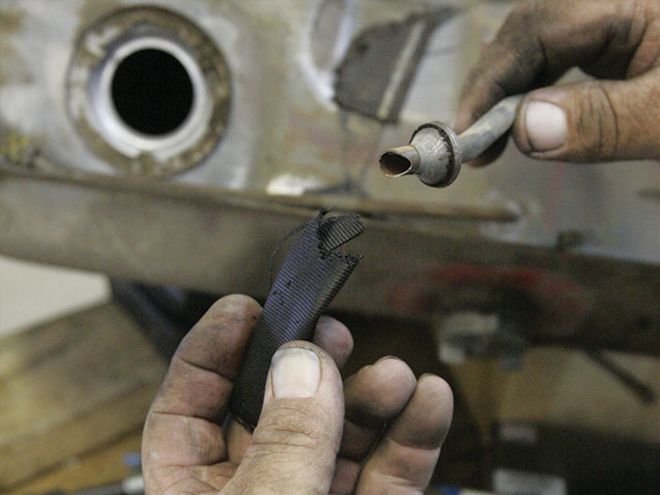
As feared, upon removal of the fuel pickup from the wagon, the sock filter disintegrated in our hands. Taylor carefully removed the tube-mounted flange and installed a replacement. The sock must be included, as it is the only filtration before the in-line pump. While the tendency might be to put a 10-micron filter ahead of the pump, that impedes pump performance. The goal is to prevent larger debris from escaping the tank and reducing pump efficiency.
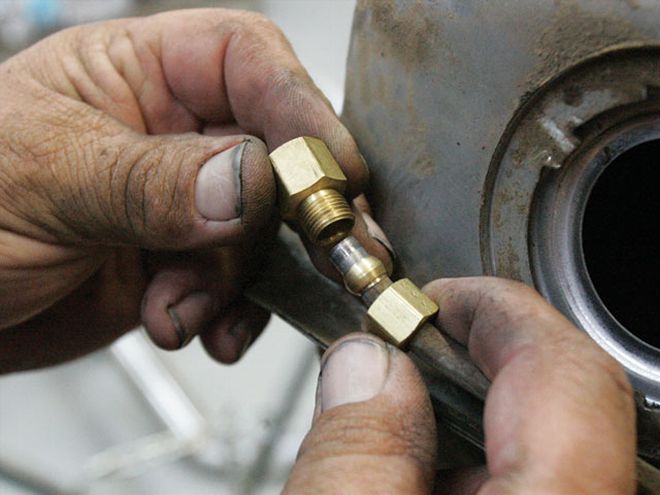
Here, Taylor modifies the 5/16-inch vapor recovery line to serve as the EFI return line. The high-pressure nature of the system aft of the fuel pump requires this ferrule-style crush connection to guarantee a leak-free system.

All fuel lines were upgraded with 300-psi-capable Push-Lok hose and fittings.